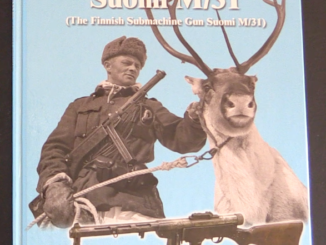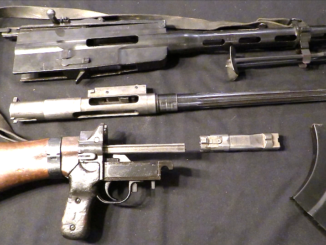While in Finland for Finnish Brutality 2021, the question naturally arose of how bolt action rifles would fare in the snow. Bloke and Chap from Bloke on the Range decided to find out, and peer-pressured me into doing the same thing with my M39 Finnish Mosin. Thanks to Sako for sponsoring the match – and for making my rifle, back in 1944!
Check out Bloke on the Range’s matching shenanigans with a No4 MkI Enfield and a pre-war MAS-36:




The Finnish M39 is certainly the best of the Mosin tribe. It shows what can be done when your workforce is well motivated, well paid and not in fear of the Gulag.
I must say that the more I watch bolt action rifles being loaded with chargers or “stripper clips”, the more sympathy I have for Mannlicher style en bloc clips.
The M39 seems fairly easy to move through the snow, it looks to have a barrel of around 24 inches, certainly less than the 28 inches of the Mosin 91/30. In film I have seen of Russian troops crawling with the Mosin, the approved technique seems to have been to slip the left thumb under the sling near to the muzzle, and pull the rifle along with yourself. It seems to work quite well, and gives you quite good control of the muzzle to avoid getting snow in the barrel. More of a problem in Finland than Arizona, obviously.
According to A.B.Zhuk barrel length is 685 mm, whilst for 1891/1930 it is 729 mm.
Daweo:
You are right, having checked, the barrel length of the M39 is given as 27 inches, overall length 47 inches. I am surprised, because it looks a lot handier than the 1891/30, which has the 28.75 inch dragoon barrel, and always looks rather unwieldy to me. The M39 seems more like a No4 in that respect.
Do Mosin chargers have to be loaded like a Lee Enfield, two up, three down, or does it rely on the feed control device to prevent rim locks instead? Ian always seem to have difficulty loading the M39, whereas we saw that the No4 and MAS36 had no such problems in that regard.
“(…)M39 seems more like a No4 in that respect.”
Note that this weapon has much different carrying paraphernalia, as https://www.jaegerplatoon.net/RIFLES3.htm states
Rifle sling system had been redigned taking inspiration taken from Swiss rifles. Rifle m/39 features steel sling loops, which allow rifle sling to be attached either under the rifle or on its left side, hence allowing easy carry either on shoulder or across back. At the same time rifle sling no longer required separate steel loops or “dog collars” (leather loops) to be used with.
“(…)M39 seems more like a No4 in that respect.”
Also do not forget about bayonet, length after fix bayonets (again according to A.B.Zhuk)
M39 – 1490 mm
Mosin 1891/30 – 1660 mm
Also note that default for Soviet forces was to have bayonet fixed
https://commons.wikimedia.org/wiki/File:RIAN_archive_819_Stalingrad%27s_defense.jpg
I do not know about Finnish regulations in this area active during Jatkosota
Bayonets were to be fixed on officer’s order only in the Finnish Army. Such an order was practically never given in actual combat. Pre-war doctrine was to fix bayonets if trench fighting was expected, but it was widely ignored, especially once an SMG could be issued to every squad. Not surpringly, shovels and puukko knives were preferred over fixed bayonets for trench fighting as well.
“(…)Mosin chargers have to be loaded like a Lee Enfield, two up, three down, or does it rely on the feed control device to prevent rim locks instead”
I do not know, but if you fear rim locks, but still want Mosin then pick karabinek wz.91/98/23 https://en.wikipedia.org/wiki/Model_91/98/23_carbine
these use rimless 7,9 x 57 mm cartridge.
The performances of the No4 and MAS36 were instructive. The problems with the aperture sights in snow would not have occurred to me. I assume this is why AK type rifles did not use them.
I imagine the Bloke was pretty cold in woolen battledress, even with a jumper underneath. It was not really designed for the Arctic. One of my relatives served in the Norway campaign in 1940 and had nightmares about it for years after. Fighting in conditions like that is only for specially trained soldiers.
“(…)Fighting in conditions like that is only for specially trained soldiers.”
Indeed, during Unternehmen Platinfuchs https://de.wikipedia.org/wiki/Unternehmen_Silberfuchs#Unternehmen_Platinfuchs SS units suffered heavy loses due to lack of mentioned training. Axis movement was stopped, stalemate ensued, Murmansk remained in Soviet hands https://en.wikipedia.org/wiki/Zapadnaya_Litsa_(river)
Ironically, the Finnish RK 62 and RK 95 both have aperture sights. They have been critized by many people for various reasons, including problems with snow. The biggest complaint has still been that an aperture sight supposedly reduces your situational awareness compared to open sights, which is something many consider a significant flaw in the typical Finnish terrain with forests and short lines of sight. Some have even called them “range sights”.
Finnish Army does have a tradition of individual markmanship going back to the Civil Guard (Suojeluskunnat in Finnish), which was disbanded in 1945, but many of the Army officers of the early Cold War era still had a history with the Civil Guard. While the AK type assault rifle was chosen for other reasons than its inherent accuracy (or lack thereof), having an accurate rifle with precision sights for semiauto fire was still considered very important by the relevant officers.
This is hilarious: Arizonan poking in snow 🙂
Thumb up for the effort.
What fun! In Finland! In winter! On your belly in deep snow, struggling with stripper clips and cleaning rods!
I can recall training in the rain at SeaTac in coastal Washington with M14s. (Yeah, I’m really that old.) The rear sights filled up with water — and filled up again as soon as you blew them clear. Qualifying with Quik Kill methods? Hey, that was our specialty.
And yet: lookit how slick that Rifle No. 4 worked. High interior finish is not a luxury.
I’d admire to watch SOMEBODY ELSE fire that course with a Krag. (No, I’m not -that- old!)
“(…)Krag(…)”
Which one exactly?
Krag-Jørgensen 6,5 mm Karabin for bergartilleri/ingeniørvåpenet M/1897
Krag-Jørgensen 6,5 mm Karabin M/1912
Krag-Jørgensen 6,5 mm Gevær M/1894
Krag-Jørgensen 6,5 mm Skarpskyttergevær M/1925
Krag-Jørgensen 6,5 mm Skarpskyttergevær M/1930
8 mm Gevær M. 1889
8 mm Rytterkarabin M. 1889
8 mm Ingeniørkarabin M. 1889
8 mm Artillerikarabin M. 1889
8 mm Fodfolkskarabin M. 1889
?
US Krag Model 1892 is the only one I ever owned or fired. Wonderfully slick action, and unjamable. I never got it in the snow, naturally; we treated our hunting tools like precious treasures. Which they were, for poor men shooting their meat.
If snow fell into the barrel of your service Mosin …
You just keep shooting.
If you can close the bolt, of course.
All this fuss with the cleaning rod is completely useless.
And, yes
https://lh5.googleusercontent.com/proxy/f_lJgXR_FD2oGqVAZ9jXKokxKMTEPaC7yRCCS4iOK5OBssopJZNLuqFE3HgTER85qSp4tiabUDqmt9SWKuLgUOwYnoPa13fYt4N2qv4wwKepwSAdD32EqUgKiEg7lDoc44fG=w1200-h630-p-k-no-nu
And don’t you eat that yellow snow,
Over there, where the Huskies go…
– Zappa
Seriously though,
There’s snow and there’s snow
The worst problems come with the stuff melting on a warm surface, the freezing again, or packing tight in a gale force wind (Finland doesn’t seem to be very windy Britain and Ireland are reckoned to have about 80% of western Europe’s wind power potential- I’ve seen too much blowing snow this year).
You’re in a firefight, the barrel gets warm, then you need to wriggle down under a cover of powder snow to stay out of sight of an advancing enemy…
Your barrel and anything else that’s warm, thaws some snow, then freezes solid,
You fall over or break through the ice of a pool or stream, and any of your equipment that was at minus whatever °C, immediately acquires a layer of ice.
It’s been crisp hard frosty weather, but, cloud cover gradually thickens, and a light fall of powdery snowflakes turns into big soggy goose feathers, then into heavy rain that turns into clear glassy ice as soon as it hits anything.
After six hours of the freezing rain, there’s 1 1/2″ to 2″ of clear ice on everything, power lines as are down, the wooden poles have snapped under the weight, trees are drooping and branches have snapped from many of them…
But, the front that dropped the freezing rain was an occluded front, the warmer air never reached ground level. It’s now a clear, starry night and well below freezing again…
You find an isolated house with a little sauna full of lovely and very friendly Finnish girls, and your rifle that is sub freezing point, gets exposed to 100% humidity at ???°C, while you let the girls spend several hours thrashing you with wet nettles, before you have to depart again into the freezing night.
Those are the conditions that freeze guns up.
And breathing on the aperture sights just adds more ice
If the barrel is cold, loose snow packed inside does not pose any threat. It will simply be pushed out by a bullet.
And if the barrel is still warm after firing, while you are fiddling with the cleaning rod, the melt water will freeze again and damage the barrel can be damaged. With a frost of 15-20 Celsius, literally a couple of tens of seconds will be enough for this.
But all the same, an incomparably great danger to the life of the barrel is the lubricant frozen inside.